Entries tagged with “Scam”.
Did you find what you wanted?
Sat 10 Sep 2011
In reference to my last post Science Shmience, ((Science Schmience is a term I took directly from the Shoo!TAG site. In my opinion, it illustrates exactly how they view the need for scientific process.)) I thought it might be interesting to spend a little time examining the Shoo!TAG fondness for continuing and relentless revisionism. The following images are archived from the Shoo!TAG site and elsewhere, and have mostly been redacted from their original pages. Unfortunately for Shoo!TAG, unlike the situation with Soviet Cold War records, nothing can ever be completely disappeared from the internet.
Shoo!TAG: What they don’t want you to see anymore, and why.


What? Claims of a successful scientific trial showing Shoo!TAG’s amazing powers, including a clear implication that the experiment was carried out with the imprimatur of Texas A&M University. All traces of this have been completely removed from the Shoo!TAG site. [Although as of this writing the material (excepting the video) can still be seen at genuineshootag.com, a site that seems to have been set up as some kind of bolthole for the taggers ]
Why? The experiment was ludicrous for numerous reasons as we discussed in Shoo Us the Science! Given the comprehensive scouring of all references to it from the site (including from the press release page, where you’d think it would normally remain if this was just a matter of bringing the website up to date), it seems likely that Texas A&M University or Dr Rainer Fink (or both) weren’t happy to have Shoo!TAG using their names.

What? A boast that the Finnish Olympic Team was using the Shoo!TAG ‘people’ product. This appeared on the Johnson Pet Trade Consultants site, which has clear links to Shoo!TAG as is easily seen by a cursory visit. It was removed only days after I questioned it here on TCA. (The site still carries complete references to the Texas A&M Field Trial and Dr Werner Fink. I anticipate that these will be removed pretty quick).
Why? It was simply a lie.

What? A claim that was on the Shoo!TAG Science page, which implied that the Japanese Ministry of Health had tested and was endorsing the product. The supposed link to a video was never forthcoming, even though the claim remained on the page for over a year. It is now gone.
Why? The assumption must be that no such test was ever done, and no such video was ever made. Either that, or the test and the video turned out to be somewhat less flattering than the ShooTaggers anticipated. I am inclined to the first explanation.

What? A strange, supposedly impartial comment left on a Yahoo Answers page by an ‘anonymous pet owner’ in answer to the question ‘Has anybody tried the ShooTag?’ The reply is undoubtedly from Melissa Rogers or Kathy Heiney (note the spruiking of the ‘trivector’ mechanism and the sudden lapse into personal ‘ownership’ with ‘In our preliminary farm tests…‘). The vague ‘European trials’ claim was also mentioned in other Shoo!TAG postings on various pet lists, and on the Shoo!TAG site. (I also draw your attention here to the mention of the supposed ‘75% effectiveness’ quotient of the Shoo!TAG, some years before that same figure was allegedly ‘proved’ by the ridiculous statistical jiggery pokery of the Texas A&M trial. Is there any clearer indication of the fact that the ShooTaggers knew how they wanted the results from that experiment to pan out well before they even started it? Science? Not even close.)
Why? As in the case of the supposed Japanese Ministry of Health tests, the European trials either didn’t ever exist, or showed Shoo!TAG in a poor light. Again I am inclined toward the former. My personal belief is that the ShooTaggers just make this stuff up because they know that, even though there is no real science to be had, they need to attempt to provide some kind of scientific legitimacy (because customers find that kind of thing impressive, right?)

What? Just one of the numerous references to the criminally indicted ‘Professor’ William Nelson (now Desiré Dubounet) that have been expunged from the Shoo!TAG domain. Nelson’s ideas featured as the sole ‘scientific’ basis for Shoo!TAG’s working principles on earlier versions of the Shoo!TAG site, and Desiré Dubounet is listed as one of the ‘inventors’ on the Shoo!TAG Patent Application.
Why? We’ve discussed Professor Nelson in quite some depth in Shoo!TAG Waterloo. A few minutes reading through that post will give you a clear idea of why no-one in their right mind would want Nelson/Dubounet anywhere near a product they hoped to have even the faintest scientific credibility.
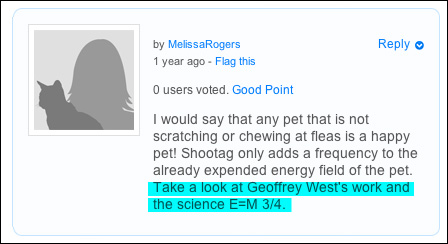
What? Melissa Rogers, Shoo!TAG CEO, shows in her own words how much she knows about science. Every single one of Rogers’ and her fellow CEO Kathy Heiney’s ridiculous pseudoscientific explanations (including several videos) of how Shoo!TAG is meant to work have been thoroughly scrubbed from the currently searchable internet.
Why? I think that is entirely self explanatory.
___________________________________________________________________________
The Complete Tetherd Cow Shoo!TAG link archive is here.
Sun 27 Jun 2010
A recent Cow commenter, Nancy, from Sweden, tells us that ShooTag is now on sale in her country. ((And TCA saved her some money! Like any good sensible person she did some research before she forked out.)) A quick lookup verifies that yes, the ShooTaggers are making inroads into Europe with the same unfounded claims of efficacy for their product as they’ve used elsewhere. Clearly, the critical faculties of the world are in dire trouble. I even turned up this link (page has been redacted by ShooTag revisionists) which trumpets that the Finnish Olympic Team ‘is now using shoo!TAG products for protection against mosquitos !!!’ I fervently hope that this is an idle boast from the sales agent and that the Finnish Olympic Team is not so stupid as to endorse this silly item.
My friends over at the JREF have pointed out, though, that Europe might not be the virgin territory that the ShooTaggers perhaps expect. Yes folks, Europe has their own flavour of pet wootag and it’s called The Anibio Tic-Clip®.
 Anibio
Anibio appears to be a German company but handily, they do have a
link to a pdf in English on their site which ‘explains’ how Tic-Clip works:
Ready-to-use tic-clip tags are carrying a specially charged layer of highly radiating, bioenergetic with a very high storage capacity. (Bioenergetic = dextropolarised electromagnetic energy). This creates a special oscillation-field around the tag and thus around the animal. Tics and fleas will not react to the animal anymore.
Whoa! Dextropolarised! Now there’s a word you don’t hear every day. You can look it up if you want – I did – but really, it’s one more instance of a new contextually-meaningless woo buzz word like ‘quantum’ or ‘magnetic’ and I won’t labour the point here. You can already tell that this ‘scientific’ explanation is just another load of baloney in the same vein as the ShooTag nonsense. And this one works without a clumsy magnetic strip! ShooTag! Your technology is so-o-o-o yesterday!
The pdf also urges the visitor to read this important information: ((We assume it’s important because the exhortation has lots of exclamation marks.))
This product was developed after many years of research together with the Germany based company Hess & Volk GmbH and has archived spectacular success in tic and flea prevention all over Europe. Many successful breeders are using it. Similar to holistic approaches you are unable to see or feel ((…or, in fact, determine any effect of…)) the Bioernergetic potential, but the positive results over the last couple of years are proving the strength of this toxin-free solution.
If you thought that the highlighted and underlined areas might prove to be a link to Messrs Hess & Volk’s ‘archive of spectacular success in tick and flea prevention’, I fear you will be bitterly disappointed. That would be altogether far too convenient. In fact, searching on Hess & Volk turns up lots of links pointing back to Anibio, but not much else. Now where oh where might we have seen that kind of behaviour before?
Elsewhere, an American distributor of Tic-Clip has some more enlightenment for us:
The mechanism of the Tic-Clip’s action is a bit abstract when compared with the traditional insect repellents, but this product is the result of many years of research and delivers results that dispel skepticism. Holistic products that work similarly with bioenergetic fields, like flower essences and homeopathic remedies, still lie outside the mainstream, but devoted users will tell you that the results can be truly amazing, even without their really understanding exactly how they work.
Hahahaha! The mechanism is a bit ‘abstract’? Judging by the rest of the paragraph, I think the phrase they’re looking for might be ‘The mechanism is a big steaming heap of claptrap’.
Still, maybe something’s being lost in interpretation here? Let’s go to the original German Anibio site with our friend the Babelfish and get it straight from the mund des pferdes.

Oooh. There’s a
graph. That’s scientific. It’s supposed to be showing us how the Tic-Clip’s effectiveness works over time. With an efficacy of 2 years at a price of €24.90 (US$36.39) it’s MUCH better value than ShooTag’s measly 4 months for US$39.95! What does Babelfish tell us that the manufacturer is offering for that money:
Ready for use TIC tie-clip supporter contains an bioenergetic load, a special layer with high radiation potential and has a high storage capacity. In the surrounding field of the supporter, and thus in the environment of the animal (independent of its size and kind of skin), develops then a special oscillation field, which protects now dogs and cats against Zecken and fleas. The TIC tie-clip supporter is fastened with the attached rings to collar or table-ware (material plays thereby no role). On the time, on which a ring is drawn by the supporter, the TIC tie-clip up to 2 works years
OK… that’s making about as much sense as anything else we’ve read I guess. Once the Tic-Clip is properly fastened to the table-ware, it does seem to offer everything that ShooTag does at least. The Tic-Clip appears to be more robust too: the site has some caveats on effectiveness, but they don’t include the lengthy excuses that ShooTag provides for conditions under which their product might not work.
So the Tetherd Cow Ahead shoppers’ advice is: If you’re on the lookout for a completely useless product that does absolutely nothing in the way of keeping insect pests off your pets, there’s no contest – you get hugely better value for money by wasting your cash on Anibio Tic-Clip® than you do on Energetic Solutions Shoo!TAG™ ((I really wonder what the ShooTag people make of something like this. Do they scoff at the opposition: ‘That’s SO far-fetched! Look at the dumb claims they’re making! That will never work!’, or do they gaze on in envy: ‘How are they doing this without a magnetic stripe? How the hell are they achieving a 2 year efficacy? Can we steal their technology?’. My brain does little flip-flops when I try to imagine how these people think.))
Mon 3 May 2010
I really love science. No matter how much stuff there is to know, there is always some more to find out, and as we saw in my recent science experiment, even the simplest of ideas can be full of rich and surprising consequences. Today I hope you will join me as we venture into the world of magnetism, electricity and digital information.
Part 1
For this part of the experiment we will need:
•A small amount of fine iron powder or iron oxide
•A magnet
•An old credit card or similar swipe card
•A magnifying glass
You can get some iron powder by filing down an old key (an iron or steel one – brass or aluminium won’t work), or even easier, by finding some iron oxide – commonly known as rust – and scraping it into a small container. You don’t need too much, but it should be as fine as you can make it.
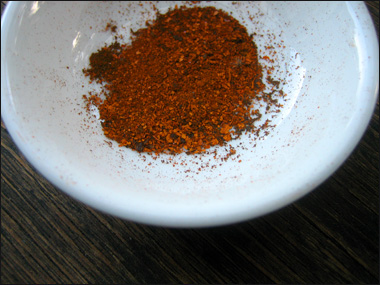
Now, I don’t think you will find it at all surprising that iron oxide is magnetic. If you take a magnet like this:
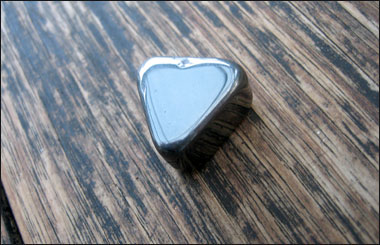
And hold it near the iron oxide, you will quite quickly see that the magnet attracts it:

The strip on a credit card is also magnetized. Here is one I’ve acquired for our experiment.
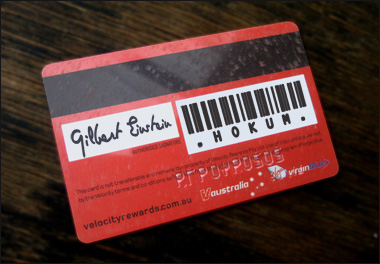
I don’t think Gilbert will mind us using his Virgin Frequent Flyer card (he doesn’t travel much anymore, after a clairvoyant told him he was going to die horribly in a plane crash). Gilbert’s card is fairly worn from carrying it around in his wallet, but we should not worry too much. The magnetic strip on a credit card is very robust and has been designed to cope with repeated handling. Although it is possible for the strip to be damaged by a very strong magnetic field, or through many years of wear and tear, the information recorded on it has a usefully long lifespan under most conditions, as I’m sure any of you with credit cards will know.
The strip on Gilbert’s card is actually really just a magnetic field that is recorded in various strengths to reflect a coding system for digital data. It is, in fact, just a magnetic field version of the common barcode with which I am sure you are familiar. The barcode records its data as a series of light and dark stripes, and the information of a swipe card is recorded in pretty much the same way, only with bands of varying magnetism. It follows then, that if we were to sprinkle something made of very fine metal powder, such as our iron oxide, onto the magnetic strip on Gilbert’s card, we would be able to see the particles sticking to the more magnetic parts of the strip.
Let’s try it!
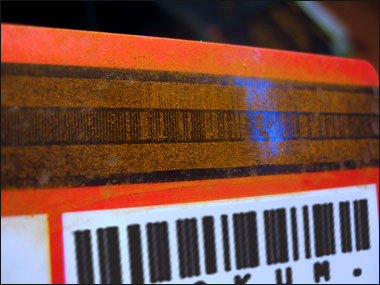
Let’s have a closer look at that with the magnifying glass!

Amazing! The fine particles clearly delineate the data on the card! What we’re seeing here tells us lots about how a credit card works. First of all, you will notice that Gilbert’s card has three horizontal magnetic bands. This is the standard for all swipe cards. In most cases, information is recorded on one, or sometimes two of these bands. The two outside bands are called high density tracks and contain data at 210 bits per inch. If you know anything about computers, you will realise that the term ‘high density’ here is relative: 210 bits per inch, by modern data standards, is pretty damn lousy. To give you some idea, one of these tracks can carry about 79 x 6bit alphanumeric characters. Your credit card would typically have, on track 1, your name, your card number and an expiry date. That’s it. Not much.
The middle strip is called the low density track and is able to carry only 40 x 4bit characters. Often, the data is similar to what is on the first track, typically a repeat of the card or account number, and the expiry date. The third track is recorded at a lower bit rate than track #1 so can carry 107 characters at 4bits each.
The important thing to note here is that a magnetic strip can carry, on all of the three stripes combined, a total of roughly 1000 bits of data. ((1062bits, if you do the sums)) You may be more familiar with that as 1k. That data is encoded to be read as alphanumeric characters, and we’re talking about, at maximum capacity, 226 letters, numbers and punctuation symbols.
That’s about the same amount of information you can send in one single SMS ((SMS messages are encoded in 7bit characters: 160 x 7bits = 1120bits))
Part 2
For this part of the experiment we will need:
•Iron oxide powder (as above)
•A Shoo!Tag™ card
(You’re really glad you stuck with me, now, aren’t you?)
Shoo!Tag™ cards are available from some pet supply places. ((Just an aside here – when I purchased my ShooTags I asked the sales assistant whether they sold many. ‘Nah’, she said ‘They’re rubbish.’)) They are small plastic credit-card style tags that the makers claim use ‘a three dimensional or trivector signature imprinted onto the magnetic field of a three field magnetic memory card to create a protective barrier from pests.’ The Shoo!Tag™ ((I’m fairly certain that they don’t actually have a trademark for Shoo!Tag, but we shall see how that pans out)) vendors don’t explain anywhere how this amazing feat is accomplished.
Here’s one I acquired earlier. It’s supposed to be for keeping ticks off cats:
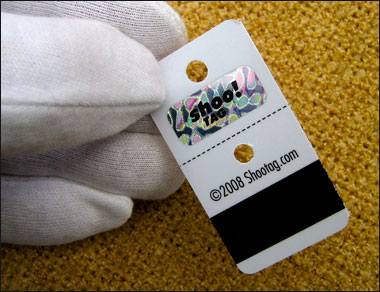
You’ll notice I’m handling it very carefully. I don’t want to damage any of the fragile ‘electro-hoodjy-goodjy vibes’ that the maker insists accompany this card. This is the packaging in which the Shoo!Tag arrived:

It’s a mylar anti-static bag, which, as you probably know, is designed to protect sensitive electrical components from static charges.

Now, static electricity has next to no effect on magnets. ((Unless we’re talking about lightning, which is a kind of static electricity. But no mylar bag is going to protect your ShooTag if it gets struck by lightning, I can assure you.)) And, as far as I can tell, there are no electrical components of any kind in the ShooTag card. ((Unless they are very very thin – alien technology, maybe? Well, that’s at least as plausible as the cards having any effect!)) What, then, is the purpose of this mylar bag? Has your American Express card ever arrived in the mail in a mylar bag? Does your bank advise you to keep your credit card in a mylar bag when not in use? They do not. Furthermore, you can build up a very decent static charge by scuffing your shoes on the carpet of your lounge room – enough to cause sparks to jump from you hand to a doorknob – but it will not effect the information on any of the credit cards in your wallet.
Ever.
But perhaps the magnetic strip of a ShooTag isn’t actually magnetic! Maybe it’s some other clever kind of technology that IS affected by static electricity. Surely it couldn’t be plain ol’ garden variety … magnetic data…
I can tell you’re ahead of me. Have you got your iron oxide powder at the ready?
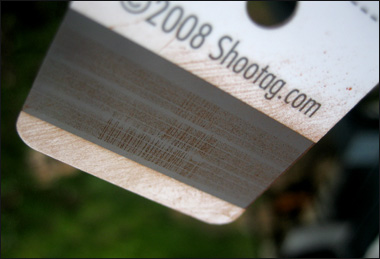
Well look at that. The magnetic strip on a ShooTag is just what you’d expect to find on a standard swipe card – three tracks encoding some data. Just like any ol’ credit card. Or a barcode. Let’s take a closer look at the actual data area of the code:
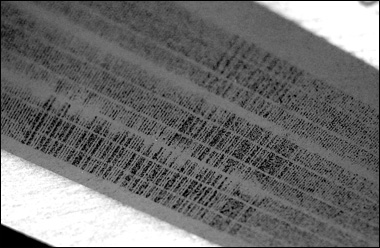
You can clearly see the actual encoded data – it forms the little segments that stand out in the middle of each of the three tracks. The uniform areas on either side, where there is no variation, are the ‘zero’ bits – null areas where the digital information message says ‘there is nothing here’.
I’ll outline it a little more clearly for you:
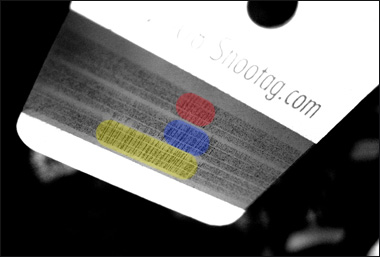
By my estimation, the actual area of the the magnetic strip that’s actually encoded with data is about a third of the total area. ((I’m being generous – it’s probably even less)) And, as you can see if you go up to the first ShooTag picture above, this card – the one for cats – is about one third the size of a standard credit card. So the information encoded on a ShooTag for cats is one third of one third of the amount of information on a standard credit card.
That’s one third of one third of the information you can send in an SMS. Roughly 17 characters.
This much:
FLEAS! PISS OFF!! ((The spaces count as characters))
Even if you assume that the digital information is not in the form of words or numerals, the total amount of data is only around 102bits. This, supposedly, is the sum total of the data used by ShooTag’s ‘physics, quantum physics and advanced computer software technology’ ((Verbatim from their ‘Science’ page)) to create the three dimensional electromagnetic field that gives it the awesome power to repel insects. Not only that, but the data also targets different insects according to which kind of card you have. Of course, this may all be explained by ‘the advanced computer software technology’ that the ShooTag creators claim they use, but in that case they are seriously in the wrong business; with data compression routines that impressive, they are trifling with a few dollars made of the back of plastic cards – they could be earning billions in Silicon Valley!
Let’s pause for a second and try and understand what kind of mechanics are supposed to be going on with these things. There is a reason, and only one reason, that information is encoded onto a magnetic strip on a plastic card. It’s a basic, practical and easy-to-understand reason: it’s so that you can swipe it through a card reader. Otherwise – seriously – WHAT IS THE POINT of recording magnetic information in this fashion? What the ShooTag people are asking us to believe is that some kind of magic happens when information is transferred onto a ShooTag magnetic strip that allows it to be scanned by… what?… the Universe? Fleas with miniature EFTPOS machines? God?
On their site the ShooTaggers say that there are ‘frequencies’ embedded in the magnetic strip ((because we can see the data, we have to assume they mean ‘recorded on’ rather than ’embedded in’)) which, using ‘earth energies similar to Schumann Waves’ (a piece of idiocy that we have discussed previously), somehow communicates with the supposed ‘bio-energetic field which surrounds all living things’. ((This is also silly doublespeak undoubtedly inherited from the misunderstandings surrounding Kirlian photography and other similar ‘proofs’ of ‘bio-energy’)) What possible mechanism could allow that? There is nothing known to science that says that a few trivial bits of magnetic data could meaningfully influence anything other a purpose-built magnetic card scanner (or some iron oxide particles, I guess). It’s nonsense of a truly breathtaking magnitude.
You will recall that I mentioned that I received 2 cards in my ShooTag package. The one we’ve been examining above is supposedly designed to repel ticks. Well, we don’t have much of a tick problem here, so I have been able to sacrifice any spooky vibes it may have had to our science experiment. The other ShooTag in my package is for the dispersal of fleas. I have been extremely careful with the other card. It has remained in its packaging and, as you saw, I have used cotton gloves whenever handling the mylar package containing the tags.
That’s because this experiment has a Part 3, and, with a certain feline helper, we are going to run our own field trial with the ShooTag. And I can assure you I will be undertaking this part of the experiment with as much rigour as any of the people who have submitted glowing testimonials on the ShooTag site.
Stay with me, won’t you?
Mon 15 Jun 2009
In case you were wondering, faithful Acowlytes, Prophet Peter Popoff still regularly communicates with me, albeit in a conversation that is fairly one-sided. He still hasn’t managed ever to respond to my questions, and one must consider that the silence after my last heartfelt offering has been decidedly chilly.
Previously, as you will recall, I had gotten a little excited that I am the only one who has made any money out of our exchange, but evidently my crowing has come to Prophet Pete’s attention. Today I received a missive in which he asks for his money back again:

Of course, that’s never going to happen, especially when he goes on to tell me that he ‘must do something very spiritual and private’ with the money. I think we all have a pretty good idea what kinds of things Prophet Pete does in the apse when no-one is around.
I am making quite a collection of Peter Popoff paraphernalia though, including, not before time, the elusive Dead Sea Salt, which arrived a few weeks back.

Prophet Pete must have known how much I’d been anticipating it – he couldn’t stop himself from scrawling his excitement on the front of the envelope:
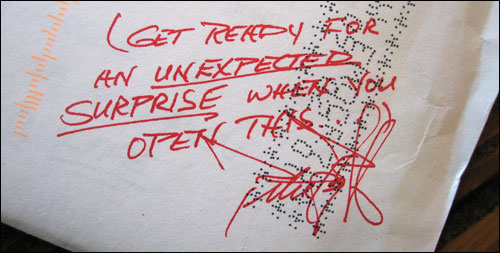
Indeed, it excited someone in the post office too, because before it arrived in my letterbox the letter had quite obviously been opened and then sticky-taped closed again:

And lest you think it was a mistake, and the letter was ‘opened in error’, a second envelope inside the first one (Prophet Pete is very fond of a little envelope-in-envelope action) was opened also:

But the Dead Sea Salt was still in there, so I can only assume that the snoop didn’t truly understand the value of the contents. ((Either that, or they stole the winning lottery ticket that Prophet Pete had thoughtfully enclosed…))
I’ve added the little salty baggy to my expanding Prophet Peter Popoff portmanteau, along with some other recent acquisitions – a golden Disk of Healing, another ten thousand dollar note, a piece of blue cloth (I can’t remember what the hell that was supposed to be), Aaron’s Rod (a toothpick in a little cotton bag), and one of Jesus’ sandals (funny, all that Bible verse and not one mention that Jesus had paper footwear).
I am confident that soon I will have enough to open the world’s first Prophet Peter Popoff museum! Admission charge will be 2c.





























